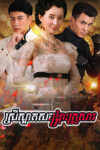Srey Sart Songkrous Krousar
Beauties at the Crossfire (2013) – A Calm Reflection on a Tale of Family, Love, and Betrayal
Chinese dramas often excel at weaving stories that blend rich family traditions, emotional conflicts, and social change. Beauties at the Crossfire (also known as Yan Yu Jiang Nan or Beauty at the Crossfires), released in 2013, is one such drama that draws viewers into a layered narrative of family entanglements, romantic struggles, and the shifting values of an era. With its detailed portrayal of relationships and its ability to balance melodrama with human vulnerability, the series leaves a lasting impression on audiences who appreciate complex storytelling.

Setting the Stage
The drama is set in the Republican era of China, a time of transition when traditional values clashed with modern ideas. This historical backdrop plays a significant role in shaping the characters’ choices and conflicts. Families held immense influence, and marriages were often arranged with little regard for individual desires. Social hierarchies, reputation, and loyalty to one’s clan weighed heavily on every decision.
Against this backdrop, Beauties at the Crossfire explores the lives of two women whose fates become intertwined through family ties and societal expectations. Their experiences reflect not only personal struggles but also the greater turbulence of the time.
The Heart of the Story
At its core, the drama revolves around two young women—Jiang Xin and Du Yunwen—who come from different backgrounds but whose destinies cross when they become part of the same powerful household. The story begins when Jiang Xin marries into the influential Du family, where Yunwen already resides. Their relationship, initially rooted in politeness and restraint, soon grows complicated as love, jealousy, and betrayal unfold.
What makes the story compelling is not simply the rivalry between the two women but the way their lives highlight deeper issues: the sacrifices women make, the pressures of family honor, and the fragile balance between love and duty. While there are moments of rivalry and tension, there is also an undercurrent of shared pain and resilience, reminding viewers that both women are products of the same restrictive system.
Themes of Love and Betrayal
Love, in this drama, is rarely simple. Jiang Xin, gentle yet strong-willed, hopes for a marriage rooted in affection, but she quickly learns that family politics dominate every relationship. Du Yunwen, on the other hand, appears poised and intelligent, but her ambitions sometimes push her into questionable choices. The men in their lives, too, struggle with conflicting loyalties, torn between genuine emotions and the expectations of their families.
Betrayal emerges as a recurring theme. Secrets, hidden motives, and shifting alliances test the bonds between characters. Yet, even in moments of heartbreak, the series avoids caricature. Instead of painting individuals as entirely good or bad, it shows how circumstances, pressures, and insecurities shape their decisions. This nuanced portrayal allows the audience to empathize even with flawed characters.
The Weight of Family Expectations
One of the strongest aspects of Beauties at the Crossfire is its exploration of family expectations. In a society where reputation mattered greatly, personal desires often took a backseat. The Du family, powerful and respected, is portrayed as both a place of security and suffocation. To be part of the household means gaining stability but also surrendering autonomy.
The clash between tradition and individuality is especially visible in the female characters. Jiang Xin longs for sincerity in her relationships, while Yunwen seeks recognition and control in a world that limits women’s choices. Their struggles speak to broader questions: How much of one’s life should be dictated by family duty? Where is the line between loyalty and self-betrayal?
Character Depth and Performances
The drama benefits greatly from its strong cast. The actresses portraying Jiang Xin and Du Yunwen bring depth to their roles, moving seamlessly between vulnerability and strength. Their performances highlight the layered emotions behind every confrontation—resentment laced with sadness, defiance tinged with fear, or love overshadowed by doubt.
Supporting characters also add richness to the story. Family elders, loyal servants, and rivals each represent different facets of the social order. Their interactions provide moments of warmth, tension, or reflection, ensuring that the drama feels textured rather than one-dimensional.
The Visual and Emotional Atmosphere
Visually, Beauties at the Crossfire captures the elegance of its era. From traditional Chinese courtyards to period costumes, every detail reflects the historical setting. The use of muted colors and atmospheric lighting reinforces the mood of restraint and formality. At the same time, moments of emotional intensity are amplified by close-ups and subtle gestures—an exchanged glance, a suppressed tear, or a strained smile.
The pacing of the drama is deliberate, allowing emotions to simmer before they erupt. Some may find the storytelling slow, but it mirrors the gradual unraveling of relationships in real life. This calm rhythm gives viewers time to reflect on the characters’ choices and sympathize with their struggles.
Lessons and Reflections
Beyond its plot twists and family intrigues, Beauties at the Crossfire invites reflection on timeless questions. It shows how love can be both empowering and destructive, how ambition can lead to both growth and downfall, and how the bonds of family can nurture as much as they constrain.
One of the most poignant takeaways is the recognition of women’s resilience. Despite facing betrayal, limited choices, and societal pressures, the female characters never lose their inner strength. They endure, adapt, and, in their own ways, seek dignity amidst hardship. This resilience makes the story more than just a melodrama; it becomes a testament to the enduring spirit of women navigating oppressive systems.
Reception and Legacy
Since its release, Beauties at the Crossfire has garnered attention for its emotional storytelling and well-constructed character arcs. While it may not be as widely known internationally as some other Chinese dramas, it has earned appreciation among audiences who value historical settings and intricate family sagas.
Its calm yet gripping approach to drama makes it appealing to viewers who enjoy narratives that unfold gradually, offering both emotional intensity and thoughtful reflection. In many ways, it stands as a reminder of how family dramas—though set in specific cultural contexts—carry universal themes of love, rivalry, and survival.
Conclusion
Beauties at the Crossfire (2013) is a drama that invites patience and empathy. It does not rely solely on grand gestures or fast-paced action but instead captures the subtle shifts in human relationships. Through its story of love and betrayal, it reflects on the timeless struggles between tradition and individuality, duty and desire, ambition and sacrifice.
For those who enjoy thoughtful storytelling set against a historical backdrop, this drama offers a rewarding experience. It leaves viewers not only with memorable characters but also with reflections on the complexities of human nature. Watching it feels like stepping into a different era—one where emotions were often hidden behind formality, yet no less powerful for it.














